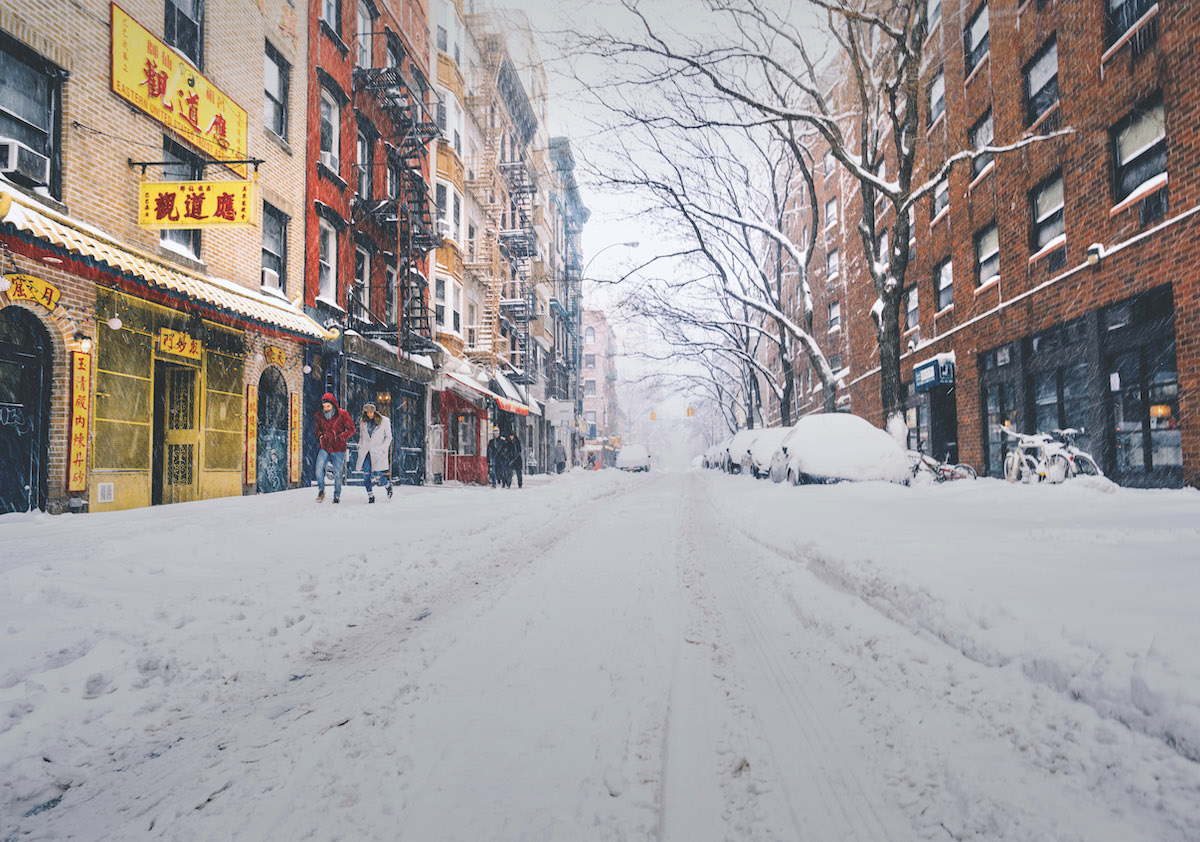A look at where Grid Ready meets NYC’s Environmental Justice Areas
Original publication by Urban Green Council • December 6, 2022
In last year’s Grid Ready, we found that building electrification poses no near-term risk to New York City’s electric grid: winter power demand could grow by 42 percent before exceeding the current summer peak demand. Now is the time to scale electrification with heat pumps to cut carbon emissions, improve air quality and keep residents at safe and comfortable temperatures year-round.
The multi-decade transition away from fossil fuel heating and hot water will evolve across a wide range of neighborhoods, building types and ownership structures. It’s critically important that electrification benefits all New Yorkers, particularly those who are more vulnerable to climate impacts, suffer worse air quality and spend a higher portion of their income on utility bills.
With that in mind, we expanded our Grid Ready analysis to explore how increasing power demand from building electrification impacts the grid in environmental justice communities.

Key takeaways
- The 15 NYC grid areas that may see the fastest electrification of heat and hot water systems and the earliest grid constraints are primarily Environmental Justice Areas.
- Many Environmental Justice Areas are dominated by smaller buildings that are easier to electrify but are served by lower-capacity power infrastructure.
- Heat pumps and other building upgrades can provide health, comfort and resilience benefits to New Yorkers who are disproportionately impacted by climate change.
- Many building electrification policies and programs are designed to ensure that resources reach vulnerable communities, and future grid planning, community engagement and policy initiatives should reinforce this priority.
Mapping Grid Ready to Environmental Justice Areas

Our Grid Ready electrification modeling found that dense residential neighborhoods outside of Manhattan like – Flatbush in Brooklyn and Fordham in the Bronx – could see an outsized share of early building electrification1 and will likely be the first to see winter electricity demand exceed summer.2
That’s the tipping point where heat pumps could drive the need for significant grid infrastructure upgrades, since the grid must be built out to meet the increasing peak power demand.
To explore the equity implications of this dynamic, we turned to New York City’s ongoing comprehensive study of environmental justice under legislation passed in 2017. As part of that effort, the City recently published an online map identifying Environmental Justice Areas across New York City that meet the legal criteria for low-income or minority communities.3
We compared these two maps and the results are striking: very high overlap between Environmental Justice Areas and neighborhoods that could be the first to encounter electrification constraints because winter power demand exceeds current grid capacities.
These neighborhoods have exciting early electrification potential because they are dominated by 1-4 family homes and low-rise residential buildings4 that rely heavily on oil and gas boilers, furnaces and water heaters. Retrofitting these building types with simple and widely available heat pumps is easier and less expensive than in larger buildings, and this work can start now. The good news is that this building electrification won’t drive winter grid constraints any time soon in Environmental Justice Areas—we likely have a decade or more to plan.
Over time, switching the sizable heating and hot water loads of residential buildings to clean, electric systems will add substantial demand to the local electric grid infrastructure in EJ areas. Currently, these loads are served primarily by gas infrastructure, so these areas tend to have lower power capacities compared to dense Manhattan neighborhoods where the grid has been built out to meet the electricity demand of large commercial buildings.5 Making buildings more efficient when they are electrified—with better air sealing, insulation and more—is essential to addressing this challenge. Efficient electrification will help keep building power demand and necessary grid investments manageable, while also reducing energy bills for residents.
There is still a lot of uncertainty about how electrification will play out across New York City. But the possibility of significant early electrification in areas with high residential heating and hot water loads and low grid capacities is important. And the overlap between those areas and the homes of low-income and minority New Yorkers requires thoughtful policy and planning to ensure an equitable transition—one that secures the benefits and mitigates potential challenges of building electrification.
Issues and opportunities
Many New Yorkers who live in Environmental Justice Areas are already experiencing serious impacts of climate change, exacerbated by decades of disinvestment and environmental racism. Heat pumps paired with other building upgrades yield many benefits, including improving resident health through better air quality and making communities more resilient during heat waves (yes, they provide both heating and cooling!). But electrification must be scaled in a manner that doesn’t pass the costs on to disadvantaged residents.
The figures below explore three key issues and opportunities to inform the path to equitable electrification.
Health impacts of air quality
Heat pumps can replace dirty fuel oil with clean, efficient heating and no local air pollution.

Issue: Environmental justice communities continue to bear the brunt of fossil fuel pollution, including from power plants, bus depots and heavy oil boilers. Burning heavy fuel oil to heat buildings releases multiple pollutants including PM2.5 with high levels of nickel, which when inhaled can have negative respiratory and cardiovascular health effects.6 Past initiatives like NYC’s Clean Heat Program successfully phased out dirty fuel oil in over 5,000 buildings, which significantly improved air quality in neighborhoods across the city.7 But major disparities persist in air pollution-related respiratory hospitalizations.
Opportunity: NYC’s current grid could accommodate the increased electric demand if every large building still burning heavy fuel oil converted to heat pumps. And there are thousands of smaller buildings still burning dirty oil too, so the potential benefits are significant. This shift would yield substantial health improvements in Environmental Justice Areas in Upper Manhattan and the Bronx, where the remaining heavy fuel oil use in large buildings is concentrated.8
Heat vulnerability
Heat pumps provide efficient, lower-cost cooling, which will save lives during heat waves and put less strain on the grid.

Issue: All New Yorkers are experiencing more frequent and longer heat waves, but our ability to manage and survive these events differs significantly. The Heat Vulnerability Index considers both geographical and socioeconomic factors to determine susceptibility to extreme heat events. Many of the city’s most heat-vulnerable neighborhoods are in Environmental Justice Areas.
Opportunity: Heat pumps ensure that residents have access to sufficient cooling during heat waves (yes, they provide both heating and cooling!). A recent analysis found that heat pumps use less electricity to maintain safe and comfortable indoor temperatures compared to conventional air conditioners, which saves residents money and puts less strain on the grid.
Energy insecurity
Heat pumps, paired with efficiency upgrades, keep homes comfortable all year long. But the costs of these improvements cannot be passed onto already energy-cost-burdened tenants in low-income communities.

Issue: Almost two million households in the NYC metro area have a high energy cost burden, paying more than six percent of yearly income towards energy costs (ACEEE). Yet many residents still lack healthy and comfortable living spaces. Professor Diana Hernández refers to this reality as energy insecurity, to better capture how the inability to meet energy needs is tied to housing conditions, adverse health impacts and socioeconomic consequences, including the “heat-or-eat” dilemma facing many low-income households. In some cases, electrification could increase heating bills, and heat pumps make it feasible to measure and even bill for heating. Many types of affordable housing have strong rent protections, but policymakers must ensure electrification does not impose higher costs on vulnerable residents or exacerbate energy insecurity for already cost-burdened New Yorkers.
Opportunity: Heat pump retrofits paired with basic energy efficiency upgrades can ensure comfortable temperatures for residents year-round—unlike the overheating and undercooling many face today. Including efficiency work alongside electrification will also lower monthly electricity costs and make homes more resilient to extreme weather. Engaging community members and environmental justice experts when developing electrification policies and programs is vital to provide safeguards like tenant protections, beneficial electric rates and financial support, which can ensure the costs of this transition aren’t borne by tenants.
Forward-looking policy and grid planning
Rapid building electrification is vital for climate progress and the health of New York City residents. Heat pumps are being installed in buildings every day across the city and this momentum will only accelerate as costs come down and new policies take effect. Governments, utilities and advocates are supporting this electrification transition through financial incentives, long-term planning, outreach, education and more—with significant focus on ensuring that support reaches vulnerable communities.
Click on each section below to learn more about electrification, efficiency and advocacy efforts across New York:

This analysis was made possible through generous support from The Energy Foundation.
1 This research explored how building power demand will change as heating and hot water systems are converted to heat pumps. We focused only on buildings both for simplicity and because they use most of NYC’s energy today. Their electrification is likely to have the biggest influence on future power demand.
2 The Grid Ready scenario displayed in this figure represents the estimated electrical demand after 30 percent of building square footage in NYC installs heat pumps for heating and hot water. This scenario does not include any supplemental efficiency or demand flexibility measure included alongside electrification. Adding efficiency or demand flexibility allows for additional electrification, but it does not change the areas where winter electricity demand exceeds summer first.
3 The definitions in Local Law 64 of 2017 are as follows: A low income community is a census block where the low income population makes up greater than or equal to 23.59 percent of the total population. A low income population is defined as a population having an annual income less than the poverty threshold set by the Census; A minority community is a census block where the minority population makes up greater than or equal to 51.1 percent of the total population. The definition of Minority population includes Hispanic, African-American or Black, Asian and Pacific Islander or American Indian populations. https://www1.nyc.gov/assets/sustainability/downloads/pdf/EJ-Report-Scope.pdf (page 6)
4 The electrification adoption modeling in Grid Ready relied on grouping building typologies based on our assessment of how easily electrification could be achieved in these buildings now and in the future. 1-4 family homes and multifamily buildings up to 7 stories were included in the group most applicable to electrification today. The full grouping of typologies is on page 42 of Grid Ready.
5 Most of New York City receives electricity through a network of underground wires and transformers buried in our streets. This underground distribution system is broken up into 70 different network areas that can be thought of as “power neighborhoods,” each with varying capacity to supply electricity.
6 The New York City Community Air Survey: Supplemental Report. Nickel Concentrations in Ambient Fine Particles: Winter Monitoring, 2008–2009.
7 Lyuou Zhang, Mike Z. He, Elizabeth A. Gibson, Frederica Perera, Gina S. Lovasi, Jane E. Clougherty, Daniel Carrión, Kimberly Burke, Dustin Fry, and Marianthi-Anna Kioumourtzoglou (2021). Evaluating the Impact of the Clean Heat Program on Air Pollution Levels in New York City. Environmental Health Perspectives 129:12 CID: 127701 https://doi.org/10.1289/EHP9976
8 “Across all building sizes, a total of 1,724 (53%) of all residential residual fuel burning buildings are located in Northern Manhattan and the Bronx.” Carrión, Daniel, Lee, W. Victoria, Hernández, Diana. (2018). Residual Inequality: Assessing the Unintended Consequences of New York City’s Clean Heat Transition. International Journal of Environmental Research and Public Health, 15(117), 10.3390/ ijerph15010117. https://www.ncbi.nlm.nih.gov/pmc/articles/PMC5800216/
We advance electrification
We're helping set the stage for electrification in NYC through our research, policy and education.
Going Electric
Electrification will be a multi-decade process. Going Electric identifies nine next steps to jumpstart electrification in multifamily buildings.
Electri-fiction to electrification: Overcoming barriers
Our 2022 conference looked at how we can tackle the remaining obstacles to electrification.
